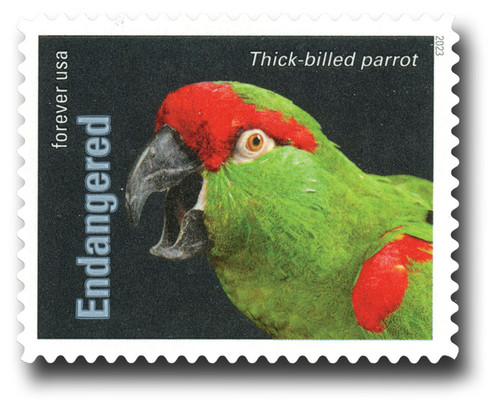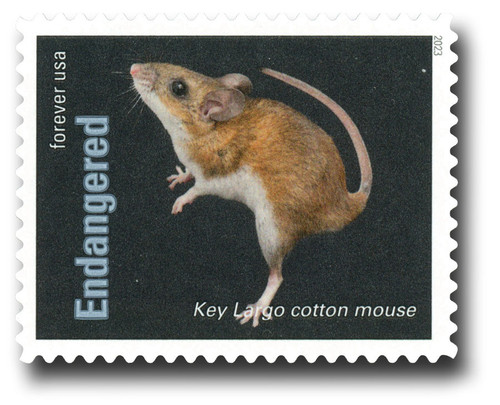
# 5799e - 2023 First-Class Forever Stamp - Endangered Species: Candy Darter
U.S. #5799e
2023 Candy Darter – Endangered Species
- Part of the Endangered Species set celebrating the 50th anniversary of the Endangered Species Act
- Design pictures a photograph by Joel Sartore’s famous “Photo Ark” project
Stamp Category: Commemorative
Set: Endangered Species
Value: 63¢, First Class Mail Rate (Forever)
First Day of Issue: May 19, 2023
First Day City: Wall, South Dakota
Quantity Issued: 30,000,000
Printed by: Banknote Corporation of America
Printing Method: Offset, Flexographic
Format: Panes of 20
Tagging: Phosphor tagged paper
Why the stamp was issued: To commemorate the 50th anniversary of the Endangered Species Act and the endangered candy darter.
About the stamp design: Like the others in the set, the photograph on the stamp is from Joel Sartore’s famous “Photo Ark” project. They are among over 13,000 the National Geographic photographer has taken in his quest to shoot photos of as many animal species as possible.
Special design details: Stamp includes “Endangered” and the common name of the species.
First Day City: First Day of Issue Ceremony was in Wall, South Dakota, at the National Grasslands Visitor Center. The center encourages visitors to see the 20 National Grasslands and Midewin National Tallgrass Prairie. These habitats are home to the black-footed ferret, one of the endangered species pictured in the set of stamps.
About the Endangered Species set: The Endangered Species Act of 1973 (ESA) was signed into law by President Richard Nixon on December 28. The legislation “protect[s] species and the ecosystems upon which they depend,” with a goal “to halt and reverse the trend toward species extinction, whatever the cost.” The ESA is jointly administered by the United States Fish and Wildlife Service and National Marine Fisheries Service.
In 2023, the US Postal Service celebrated the 50th anniversary of the ESA with a set of 20 Forever stamps. The stamps were issued on Endangered Species Day, which lands on the third Friday in May. Each design pictures a different endangered species, representing only a small handful of the over 1,300 plants and animals protected under the ESA as of 2023. The images used for the stamps were part of Joel Sartore’s “Photo Ark.” Partnering with National Geographic, he set out to capture 20,000 species living in zoos and wildlife sanctuaries around the world. Together, they are determined to intimately picture each species in order to educate and bring awareness to their preservation. Sartore calls his work as a photographer a “mission to document endangered species and landscapes in order to show a world worth saving.”
Thanks to the ESA, many plant and animal species that were once endangered have made a comeback. With the continued effort of conservationists, volunteers, and increased awareness, even more species can make their way back from the brink of extinction one day.
History the stamp represents: The candy darter (Etheostoma osburni) is a fish in the family Percidae. It is found in the eastern United States, specifically the Kanawha River system in Virginia and West Virginia. Its relatively small range led to the species being listed as endangered by the US Fish and Wildlife Service in 2018.
Candy darters are small fish that reach a length of approximately three inches when fully grown. Males have black “saddle” marking on their backs with red-orange and blue-green bands running along the sides of their bodies. Females are similarly marked but with a mostly olive green and black coloration. Candy darters prefer rocky riverbeds with clear water. They do not mind fast currents and can tolerate cold, cool, or warm water temperatures. The species has a life expectancy of three years, with breeding beginning at two years. Young fish tend to spend more time in calmer, shallower streams than adults.
In addition to the candy darter, the variegate darter was introduced to the same areas. Unfortunately, the latter has begun to hybridize with the candy darter. This has led to true candy darter fish being replaced by variegate darters over time. Pollution and habitat destruction have also reduced candy darter numbers. It may be an uphill battle for these brightly colored little fish, but there is still hope for them to recover in time.
U.S. #5799e
2023 Candy Darter – Endangered Species
- Part of the Endangered Species set celebrating the 50th anniversary of the Endangered Species Act
- Design pictures a photograph by Joel Sartore’s famous “Photo Ark” project
Stamp Category: Commemorative
Set: Endangered Species
Value: 63¢, First Class Mail Rate (Forever)
First Day of Issue: May 19, 2023
First Day City: Wall, South Dakota
Quantity Issued: 30,000,000
Printed by: Banknote Corporation of America
Printing Method: Offset, Flexographic
Format: Panes of 20
Tagging: Phosphor tagged paper
Why the stamp was issued: To commemorate the 50th anniversary of the Endangered Species Act and the endangered candy darter.
About the stamp design: Like the others in the set, the photograph on the stamp is from Joel Sartore’s famous “Photo Ark” project. They are among over 13,000 the National Geographic photographer has taken in his quest to shoot photos of as many animal species as possible.
Special design details: Stamp includes “Endangered” and the common name of the species.
First Day City: First Day of Issue Ceremony was in Wall, South Dakota, at the National Grasslands Visitor Center. The center encourages visitors to see the 20 National Grasslands and Midewin National Tallgrass Prairie. These habitats are home to the black-footed ferret, one of the endangered species pictured in the set of stamps.
About the Endangered Species set: The Endangered Species Act of 1973 (ESA) was signed into law by President Richard Nixon on December 28. The legislation “protect[s] species and the ecosystems upon which they depend,” with a goal “to halt and reverse the trend toward species extinction, whatever the cost.” The ESA is jointly administered by the United States Fish and Wildlife Service and National Marine Fisheries Service.
In 2023, the US Postal Service celebrated the 50th anniversary of the ESA with a set of 20 Forever stamps. The stamps were issued on Endangered Species Day, which lands on the third Friday in May. Each design pictures a different endangered species, representing only a small handful of the over 1,300 plants and animals protected under the ESA as of 2023. The images used for the stamps were part of Joel Sartore’s “Photo Ark.” Partnering with National Geographic, he set out to capture 20,000 species living in zoos and wildlife sanctuaries around the world. Together, they are determined to intimately picture each species in order to educate and bring awareness to their preservation. Sartore calls his work as a photographer a “mission to document endangered species and landscapes in order to show a world worth saving.”
Thanks to the ESA, many plant and animal species that were once endangered have made a comeback. With the continued effort of conservationists, volunteers, and increased awareness, even more species can make their way back from the brink of extinction one day.
History the stamp represents: The candy darter (Etheostoma osburni) is a fish in the family Percidae. It is found in the eastern United States, specifically the Kanawha River system in Virginia and West Virginia. Its relatively small range led to the species being listed as endangered by the US Fish and Wildlife Service in 2018.
Candy darters are small fish that reach a length of approximately three inches when fully grown. Males have black “saddle” marking on their backs with red-orange and blue-green bands running along the sides of their bodies. Females are similarly marked but with a mostly olive green and black coloration. Candy darters prefer rocky riverbeds with clear water. They do not mind fast currents and can tolerate cold, cool, or warm water temperatures. The species has a life expectancy of three years, with breeding beginning at two years. Young fish tend to spend more time in calmer, shallower streams than adults.
In addition to the candy darter, the variegate darter was introduced to the same areas. Unfortunately, the latter has begun to hybridize with the candy darter. This has led to true candy darter fish being replaced by variegate darters over time. Pollution and habitat destruction have also reduced candy darter numbers. It may be an uphill battle for these brightly colored little fish, but there is still hope for them to recover in time.














